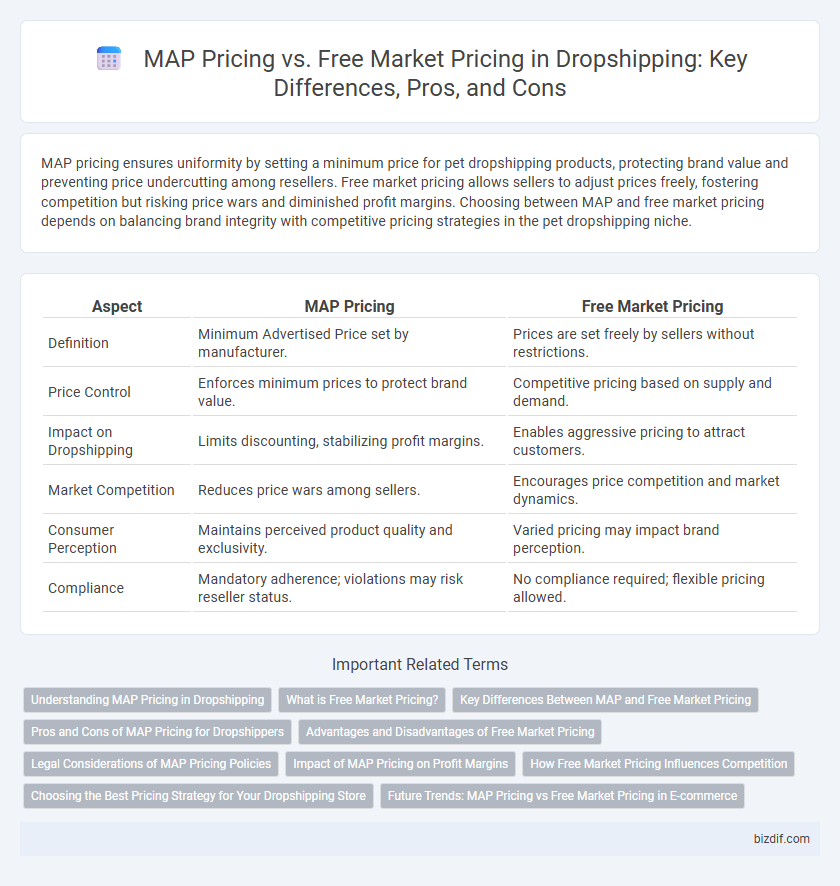MAP pricing ensures uniformity by setting a minimum price for pet dropshipping products, protecting brand value and preventing price undercutting among resellers. Free market pricing allows sellers to adjust prices freely, fostering competition but risking price wars and diminished profit margins. Choosing between MAP and free market pricing depends on balancing brand integrity with competitive pricing strategies in the pet dropshipping niche.
Table of Comparison
| Aspect | MAP Pricing | Free Market Pricing |
|---|---|---|
| Definition | Minimum Advertised Price set by manufacturer. | Prices are set freely by sellers without restrictions. |
| Price Control | Enforces minimum prices to protect brand value. | Competitive pricing based on supply and demand. |
| Impact on Dropshipping | Limits discounting, stabilizing profit margins. | Enables aggressive pricing to attract customers. |
| Market Competition | Reduces price wars among sellers. | Encourages price competition and market dynamics. |
| Consumer Perception | Maintains perceived product quality and exclusivity. | Varied pricing may impact brand perception. |
| Compliance | Mandatory adherence; violations may risk reseller status. | No compliance required; flexible pricing allowed. |
Understanding MAP Pricing in Dropshipping
MAP pricing in dropshipping ensures brand consistency by setting the minimum advertised price that resellers must adhere to, preventing price wars and protecting retailer margins. This pricing strategy helps manufacturers maintain product value across multiple online platforms while enabling dropshippers to compete fairly without undercutting each other. Understanding MAP pricing is crucial for dropshippers to comply with supplier policies and avoid penalties or loss of selling privileges.
What is Free Market Pricing?
Free Market Pricing allows sellers to set product prices based on supply and demand without restrictions, resulting in dynamic price fluctuations influenced by competition and consumer behavior. In dropshipping, this model can lead to diverse price points across different sellers, fostering competitive advantages and potential margin variations. Unlike MAP pricing, Free Market Pricing provides flexibility but may reduce price consistency and brand value control.
Key Differences Between MAP and Free Market Pricing
MAP pricing enforces a minimum advertised price set by manufacturers to maintain brand value and prevent price wars among dropshippers. Free market pricing allows dropshippers to set any retail price based on supply, demand, and competition, often leading to lower prices but potential brand dilution. Understanding these key differences helps dropshippers balance competitive pricing strategies with manufacturer compliance requirements.
Pros and Cons of MAP Pricing for Dropshippers
MAP pricing ensures consistent brand value and protects sellers from price undercutting, fostering trust and preventing price wars in dropshipping markets. However, it limits flexibility for dropshippers to adjust prices based on demand fluctuations or competitive strategies, potentially reducing profit margins. Adhering to MAP can also simplify inventory management but may alienate customers seeking lower prices, impacting sales volume.
Advantages and Disadvantages of Free Market Pricing
Free Market Pricing allows sellers to set prices based on supply, demand, and competitor behavior, promoting flexibility and potential for higher profit margins in dropshipping. However, this pricing strategy can lead to price wars, reduced brand value, and inconsistent customer experiences due to significant price variations across sellers. Unregulated pricing may also result in lower overall market stability and challenges in maintaining vendor relationships.
Legal Considerations of MAP Pricing Policies
Minimum Advertised Price (MAP) policies regulate the lowest price retailers can advertise, aiming to protect brand value and retailer margins without fixing final sale prices. These policies must comply with antitrust laws such as the Sherman Act in the U.S., ensuring they do not constitute illegal price-fixing or restraint of trade. Violations can result in significant legal penalties, making it crucial for dropshipping businesses to carefully design MAP policies that avoid direct price-setting and allow competitive free market pricing at the point of sale.
Impact of MAP Pricing on Profit Margins
Minimum Advertised Price (MAP) policies help protect profit margins by preventing retailers from advertising products below a set price, ensuring consistent pricing across channels and reducing price wars. By enforcing MAP pricing, dropshippers can maintain healthy margins despite competitive pressures, as it restricts the downward price spiral often seen in a free market. This control over advertised prices leads to stronger brand value and allows for more predictable revenue streams.
How Free Market Pricing Influences Competition
Free Market Pricing in dropshipping fosters intense competition by allowing sellers to set variable prices based on demand, inventory, and competitor actions. This dynamic pricing strategy often leads to lower prices and improved value for consumers, driving innovation among sellers. Unlike MAP Pricing, free market pricing encourages flexible responses to market conditions, enhancing competitiveness across the dropshipping ecosystem.
Choosing the Best Pricing Strategy for Your Dropshipping Store
Choosing the best pricing strategy for your dropshipping store involves understanding Minimum Advertised Price (MAP) policies versus free market pricing flexibility. MAP pricing enforces manufacturer-set minimum prices to maintain brand value and prevent price wars, which can protect profit margins and brand reputation. In contrast, free market pricing allows full control over setting discounts and promotions, enabling competitive pricing strategies tailored to customer demand and market trends.
Future Trends: MAP Pricing vs Free Market Pricing in E-commerce
Future trends in e-commerce indicate a shift towards more dynamic pricing strategies, where MAP (Minimum Advertised Price) policies coexist with emerging free market pricing models driven by AI and real-time data analytics. Retailers leveraging MAP pricing maintain brand value and prevent price erosion, while free market pricing fosters competitive pricing and increased consumer choice through transparent, algorithm-driven adjustments. Balancing these approaches requires sophisticated software tools that monitor competitor prices and ensure compliance while optimizing profitability in an increasingly digital and globalized dropshipping landscape.
MAP Pricing vs Free Market Pricing Infographic

 bizdif.com
bizdif.com